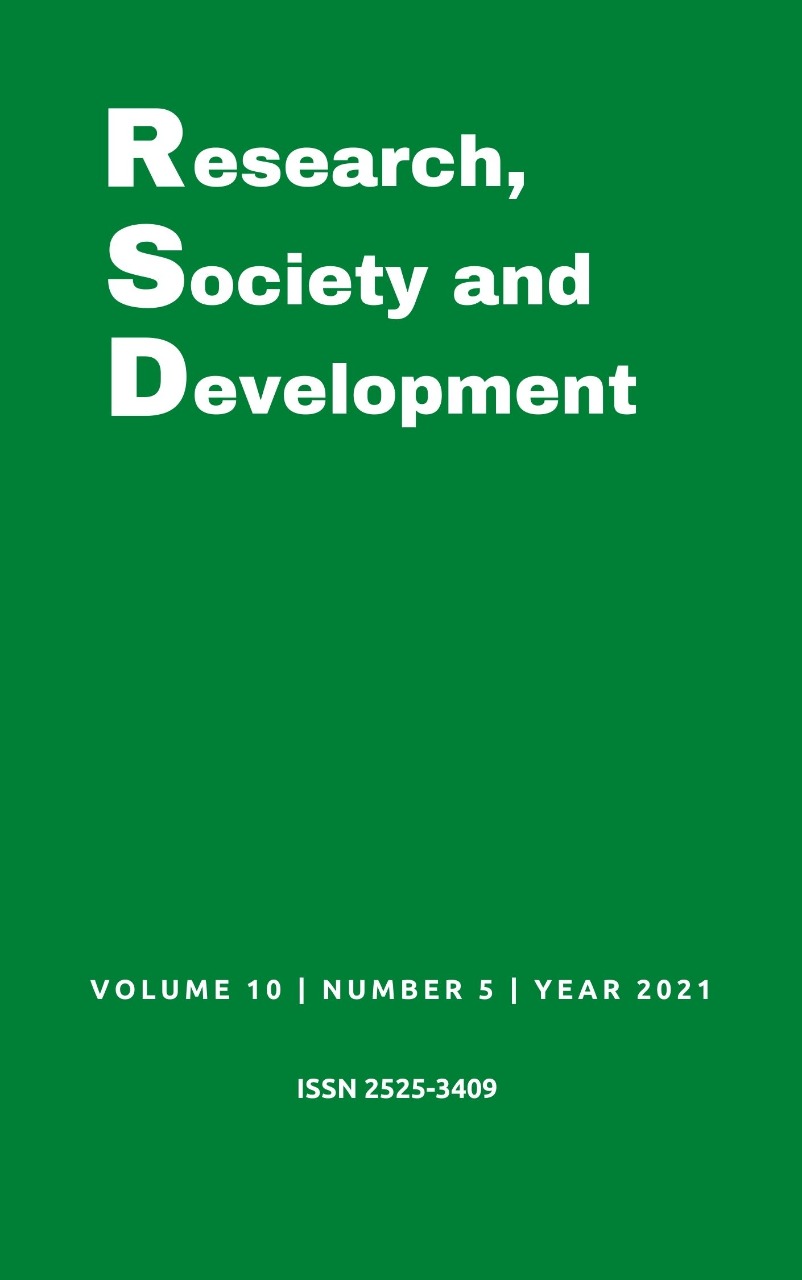Arte-Educação, Transtorno do Espectro Autista-TEA e possibilidades educativas
DOI:
https://doi.org/10.33448/rsd-v10i5.14842Palavras-chave:
Transtorno do espectro autista- TEA; Arte-educação; Desenvolvimento infantil.Resumo
O estudo teve como objetivo compreender a criança com Transtorno do Espectro Autista (TEA) na primeira infância (de zero a dois anos), refletindo sobre as possiblidades construtivas da Arte-Educação para o desenvolvimento e aprendizagem da criança. O TEA é caracterizado por dificuldades no desenvolvimento da linguagem, nos processos de comunicação e por déficits nos processos de socialização. A Arte pode proporcionar experiências e oportunidades de construção sensoriais, cognitivas e afetivas, e que dialoga com intervenções terapêuticas- pedagógicas na Educação de crianças atípicas com dificuldades na interação social e na comunicação. A pesquisa de abordagem qualitativa foi realizada por meio de entrevista narrativa com a mãe de uma criança com TEA. Os resultados sugerem que a criança desde os primeiros meses apresentou sinais do TEA como: dificuldade de amamentação, a ausência de contato visual, descontentamento nos momentos de toque, pouca reação a voz humana, fixação por objetos que pudessem ser girados e um padrão repetitivo de organização. A arte desperta, no bebê, múltiplas sensações: cria laços afetivos, promove o aconchego, estimula percepções sensoriais e movimento e precisam ser estimulados para essa expressão. Conclui-se que a criança com TEA na primeira infância, pode se beneficiar das possiblidades construtivas da Arte-Educação, como fator benéfico para o progresso interativo da criança.
Referências
André, M. (2019). O que é um estudo de caso qualitativo em educação? Revista da FAEEBA - Educação E Contemporaneidade, 22(40), 95-103.
American PsyquiatricAssociation - APA (2013). Tradução: Maria Inês Corrêa Nascimento et al, revisão técnica: Aristides Volpato Cordioli...et al.). Manual diagnóstico e estatístico de transtornos mentais: DSM – 5 - 5ª ed. – Porto Alegre: Artmed.
Bardin, L. (2011). Análise de conteúdo. São Paulo: Edições 70.
Brasil. Ministério da Saúde. (2014). Diretrizes de Atenção a Reabilitação da Pessoa com Transtorno do Espectro do Autismo.
Bosa, C. A.& Hoher, S.P. (2009). Autismo e Inclusão Possibilidades e Limites. In M.Gomes (Org.), Construindo as trilhas para a inclusão. Rio de Janeiro: Vozes.
Brazelton, T. B. (2006). O Grande Livro da Criança: o desenvolvimento emocional e do comportamento durante os primeiros anos. (9a ed.). Lisboa: Editorial Presença.
Camargo, S. P. H., & Bosa, C. A. (2012). Competência social, inclusão escolar e autismo: um estudo de caso comparativo. Psicologia: Teoria e Pesquisa, 28(3), 315-324.
Faro, K. C. A., Santos, R. B., Bosa, C. A., Wagner, A., & Silva, S. S. da C. (2019). Autismo e mães com e sem estresse: análise da sobrecarga materna e do suporte familiar. Psico, 50(2), e30080.
Fernandes, L. B. (2010). Ensino de arte no universo autista: um relato de Extensão da Faculdade de Artes do Paraná. (Dissertação de Mestrado). Faculdade de Artes, Universidade Tuiuti do Paraná, Curitiba, Brasil.
Fernandes, L B., Schlesener, A., Mosquera, C.& Teixeira, R. M. (2012). Ensino de Arte e Autismo: Um Relato de Extensão. Revista Educação, Artes e Inclusão. 5(1).
Hoehl, S. & Striano, T. (2010). Discrete Emotions in Infancy: Perception without Production? Emotion Review. 2, 132-133.
Holm, A. M. (2007). Baby - Art: os primeiros passos com a arte. São Paulo: Museu de Arte Moderna de São Paulo.
Homercher, B. M., Peres, L. S., Arruda, L. F. S., & Smeha, L. N (2020). Observação Materna: Primeiros Sinais do Transtorno do Espectro Autista Maternal. Estudos e Pesquisas em Psicologia, 20 (2), 540-558.
Jovchelovich, S.& Bauer, M. W. (2002). Entrevista Narrativa. In M. W. Bauer & G. Gaskell (Orgs), Pesquisa qualitativa com texto, imagem e som: um manual prático (pp.90-113). Petrópolis: Vozes.
Klin, A. (2006). Autismo e síndrome de Asperger: uma visão geral. Revista Brasileira de Psiquiatria, 28 (1), 3-11.
Minayo, M. C.de S.(2002). Ciência, técnica e arte: o desafio da pesquisa social. In M. C.de S. Minayo, (Org.), Pesquisa social: teoria, método e criatividade (pp.9-29). Petrópolis: Vozes.
Orrú, S. E. (2011). Autismo: o que os pais devem saber? (2a ed.). Rio de Janeiro: Wak.
Otta, E. (1994). O sorriso e seus significados. Petrópolis, RJ: Vozes.
Papalia, D. E., Olds, S. W. & Feldman, R. D. (2020 ). O mundo da criança (8a ed.). Lisboa: McGraw-Hill.
Rubim, A.L & Matos, D.C (2020). Comparação de tipos de pistas sobre o jogo funcional em crianças com transtorno do espectro do autismo. Research, Society and Development , 9 (7), e465974392.
Santos, M. C. A. (2015). Entre a vivência com educadores e a proposta com alunos com transtorno do espectro autista (TEA): estudo de atividades de arte com materiais de exploração sensorial. (Dissertação). Programa de Pós Graduação da Faculdade de Ciências Médicas da Universidade Estadual de Campinas, Campinas, SP, Brasil.
Seidl-de-Moura, M.L, Ribas, A. F.P, Seabra, K.da C., Pessôa, L. F., Nogueira, S. E., Mendes, D.M. L. Rocha, S. B & Vicente, C. (2008). Interações mãe-bebê de um e cinco meses: aspectos afetivos, complexidade e sistemas parentais predominantes. Psicologia: Reflexão e Crítica, 21(1), 66-73.
Zanin, L.F. (2014). Novas tecnologias e processos de significação na arte e na educação. Anais do 23º Encontro da ANPAP – “Ecossistemas Artísticos”, Belo Horizonte, Brasil.
Downloads
Publicado
Como Citar
Edição
Seção
Licença
Copyright (c) 2021 Joel Cardoso; Neide Maria Fernandes Rodrigues de Sousa; Francisco Pereira Oliveira

Este trabalho está licenciado sob uma licença Creative Commons Attribution 4.0 International License.
Autores que publicam nesta revista concordam com os seguintes termos:
1) Autores mantém os direitos autorais e concedem à revista o direito de primeira publicação, com o trabalho simultaneamente licenciado sob a Licença Creative Commons Attribution que permite o compartilhamento do trabalho com reconhecimento da autoria e publicação inicial nesta revista.
2) Autores têm autorização para assumir contratos adicionais separadamente, para distribuição não-exclusiva da versão do trabalho publicada nesta revista (ex.: publicar em repositório institucional ou como capítulo de livro), com reconhecimento de autoria e publicação inicial nesta revista.
3) Autores têm permissão e são estimulados a publicar e distribuir seu trabalho online (ex.: em repositórios institucionais ou na sua página pessoal) a qualquer ponto antes ou durante o processo editorial, já que isso pode gerar alterações produtivas, bem como aumentar o impacto e a citação do trabalho publicado.

